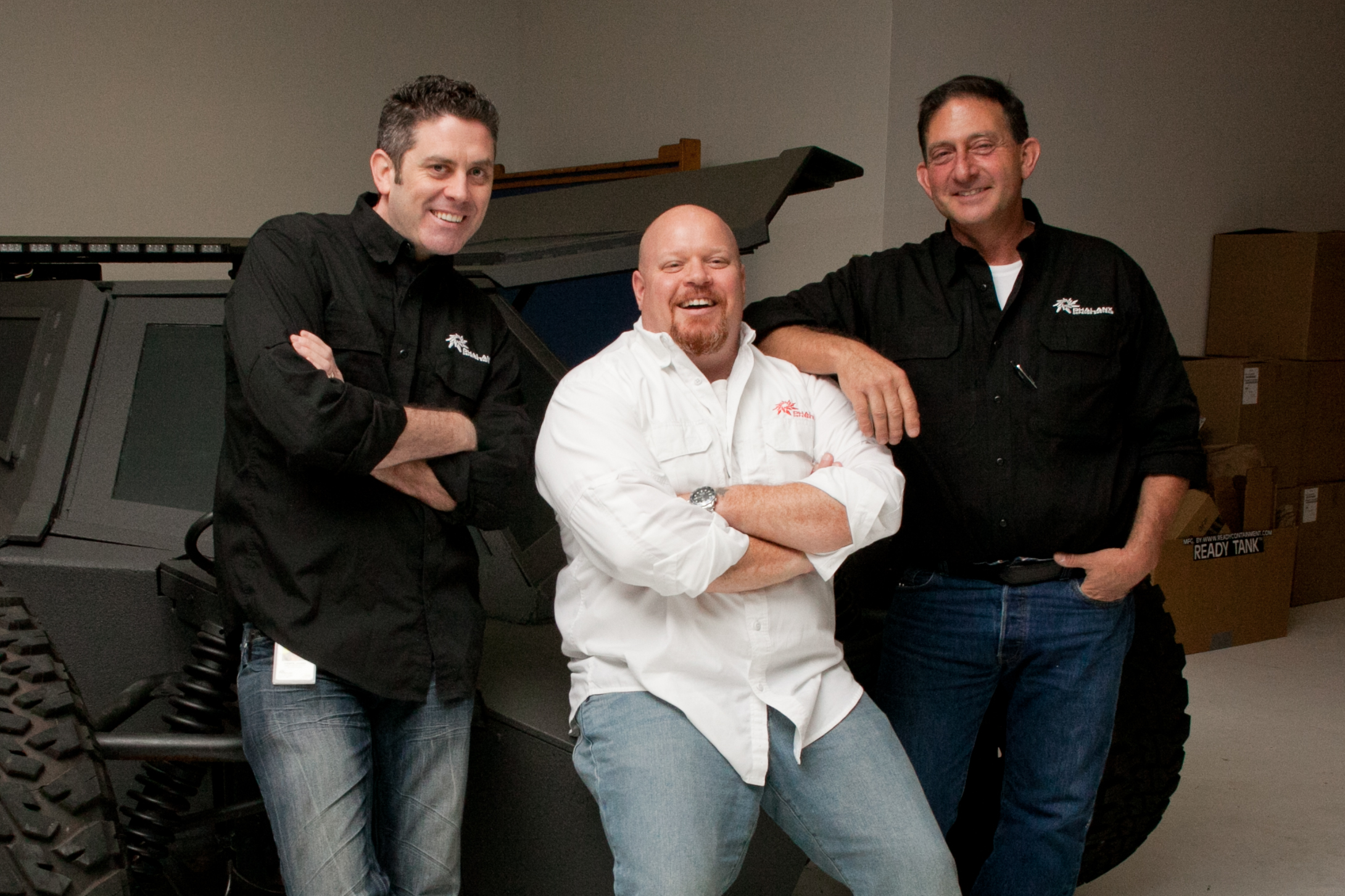
By Leah Spellman Craig
Tucked away on the airfield at Gainesville Regional Airport in a 10,000-square-foot building is Phalanx Defense Systems. After being buzzed in, a life-size Iron Man statue greets guests—a precursor of the comic-book like inventions and defense technologies created within these walls.
“We do what most people think is impossible,” said James Coats, CEO/applied sciences, a title that he, along with his two business partners—Justin Mowitz, chief operating officer/general counsel, and John Perkins, chief technology officer—said means little to them. “When we tell people we’ve created the real Batmobile, they think we’re full of it. Then when we bring them in they say, “Oh my God. You did.”
Inside the manufacturing area is the M.A.N.T.I.S.S. (mechanical, armored, navigation, terrain, interface stealth, system). The black-armored extraction vehicle that is virtually invisible at night has been more than three years in the making and is the first of its kind. It has a low radar signature, thermal drive system, gull-wing doors and ballistic glass. Not to mention it can climb rocks and stairs and plow down fences. By the time this article goes to print, the vehicle will be long gone. Coats cannot share details on who is purchasing it or where it is going.
“Our job is not to create weapon systems; we create life-saving equipment for local, state and federal law enforcement agencies, the Special Forces and the Department of Defense,” said Coats, whose resume includes designing illusions for David Copperfield and Siegfried and Roy during his eight years as a professional magician, creating color-changing armor for military application and working as an advanced development engineer for the one of the world’s largest defense contractors.
Phalanx opened in October 2012, just more than a year after the idea and perfect team fell into place. Coats and Mowitz, a former Marine and lawyer, met because their children attended the same school. They toyed with the idea of starting their own company as a way to find greater professional satisfaction. Coats was already working with Perkins, who has a background in ballistic solutions and engineering, and his company Basic Black, so he spearheaded a plan to bring the group together.
After several months of renovation, the staff moved into the former Federal Aviation Administration Flight Services building. The arcade games in the break room, life-size Star Wars storm trooper and shadow trooper statues in the conference room and ballistics testing lab at the end of the hall prove this is not your typical office.
Fostering Innovation
When it comes to invention, Coats said the two must-have components are the gathering of open-minded people and believing anything is possible. “For instance, if you were to talk about invisibility to most people, they would think you were crazy,” he said. “We figure out how to make it happen.”
Seeing the end solution to a problem and working backwards is another aspect of the development process. “Shootings are everywhere, from mass killings to officer-involved shootings,” Perkins said. “We develop technology that can lessen the impact of incidents like these in the future.”
Phalanx’s latest product, Emergency Body Armor, is one the team sees fit for civilian use. Retailing at $200, the vest fits all sizes, from adults to children, can be worn or held up, is less than 6 pounds, and is moldable so it can easily fold up in a bag. The armor is also a symbol of the quality Phalanx demands of its products. The industry standard for testing body armor is that it must stop one round. Phalanx’s stops multiple. One recently tested panel already had six .44 Magnum rounds in it when they tested two more 12-gage rounds designed to penetrate body armor. Emergency Body Armor held up under fire.
“We don’t cut corners,” Perkins said. “And we don’t have that multiplier that says nothing leaves this place without a five-time markup. That’s not how we look at things. For us, the next question is always, ‘Is it enough?’ And ‘good enough’ is never enough. We engineer and re-engineer until we are all satisfied with the product.”
What’s Next?
Phalanx currently has a dozen products on the market through retail stores and Amazon.com, with price tags ranging from $200 to $4,500. Nearly 100 percent of its items are manufactured in the U.S. Local business partnerships are also important to the Phalanx team. Emergency Body Armor, for example, is almost entirely manufactured in Gainesville.
The company will soon unveil a police shield that offers protection and full optical clarity, as well as a recycling program that will save taxpayers millions of dollars. “The average bullet-proof vest is $683 and has a five-year manufacturers’ warranty,” Perkins said. “We will inspect and recondition vests so they can be used for a few additional years.”
Remembering Their Mission
According to the National Law Enforcement Officers Memorial Fund, 127 police officers were killed in the line of duty last year. Mowitz said the company plans to keep its team connected to its mission of saving lives by presenting its annual White-Hanlin Award. Matt Hanlin, a Clay County Sheriff’s deputy and one of the award’s namesakes, was the first to receive the award in October 2012. Hanlin was shot in the bicep during a shootout at an alleged meth house and is alive because of one of Coats’ former company’s products.
“Taking time to present this award will keep us grounded and will remind us of the reason we are doing what we’re doing,” Mowitz said. “The corners we don’t cut save lives.”


